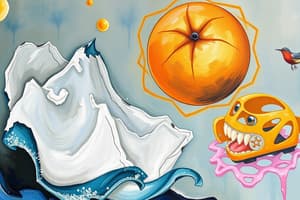Podcast
Questions and Answers
What is one main purpose of tone in composition?
What is one main purpose of tone in composition?
- To create balance with color
- To show depth and contrast (correct)
- To change the hue of a color
- To eliminate shadows
Hue refers to the lightness or darkness of a color.
Hue refers to the lightness or darkness of a color.
False (B)
Name one characteristic of color that alters its lightness.
Name one characteristic of color that alters its lightness.
Value
The use of color in composition can convey ______ or emotions.
The use of color in composition can convey ______ or emotions.
Match the following artworks with their corresponding artists:
Match the following artworks with their corresponding artists:
What are some types of lines used in visual arts?
What are some types of lines used in visual arts?
Shapes in art can only be geometric, such as squares and circles.
Shapes in art can only be geometric, such as squares and circles.
What is the primary function of line in visual arts?
What is the primary function of line in visual arts?
In visual arts, ________ refers to the area within and around objects.
In visual arts, ________ refers to the area within and around objects.
Match the following shapes with their type:
Match the following shapes with their type:
Which of the following best describes a function of shapes in art?
Which of the following best describes a function of shapes in art?
Lines have no psychological impact in artistic composition.
Lines have no psychological impact in artistic composition.
Name one famous artwork that utilizes line in its composition.
Name one famous artwork that utilizes line in its composition.
What does positive space refer to in visual arts?
What does positive space refer to in visual arts?
Negative space refers to the physical presence of objects in a composition.
Negative space refers to the physical presence of objects in a composition.
Define the difference between shape and form.
Define the difference between shape and form.
Texture in visual arts can be actual (tactile) or ______ (visual).
Texture in visual arts can be actual (tactile) or ______ (visual).
Match the following terms with their definitions:
Match the following terms with their definitions:
Which of the following artworks is known for its use of texture?
Which of the following artworks is known for its use of texture?
Form includes only height and width in the representation of an artwork.
Form includes only height and width in the representation of an artwork.
What does tone in visual art often convey?
What does tone in visual art often convey?
Flashcards are hidden until you start studying
Study Notes
Introduction to Visual Arts
- Visual arts encompass different forms of expression using artistic elements to communicate ideas, emotions, and experiences.
- Understanding these fundamental elements is crucial for both creation and appreciation of art.
Definition of Visual Arts
- Visual arts are art forms primarily visual in nature, including painting, drawing, sculpture, and photography.
- These mediums engage the viewer's sense of sight and can provoke thought, elicit emotions, and convey messages creatively.
Line
- Line is the foundation of all drawing.
- It is the most versatile of the visual elements of art.
- Lines can be categorized as straight, curved, horizontal, vertical, diagonal, and many more.
- Each type of line has specific emotional and psychological impacts, influencing the overall perception of the artwork.
Shape
- Shape refers to a two-dimensional area defined by edges or lines.
- It can be geometric, like squares and circles, or organic, resembling forms found in nature.
Space
- Space refers to the area within and around objects.
- It can be manipulated to create various effects, influencing how the viewer perceives depth and distance in a composition.
- Positive space refers to the area occupied by objects.
- Negative space is the void around those objects.
Form
- Form refers to the three-dimensional quality of an object in visual arts.
- It includes height, width, and depth, allowing for a more realistic representation in artworks, such as sculptures and installations.
Texture
- Texture refers to the surface quality of an object, perceived through touch or sight.
- In visual arts, texture can be actual (tactile) or implied (visual), enriching the artwork by adding dimension and interest.
Tone
- Tone in visual art refers to the overall mood or atmosphere created by the artist through color, composition, and subject matter.
- It can range from cheerful and uplifting to somber and melancholic.
Color
- Color is the spectrum of light broken down when hitting a surface and reflected into the eye.
- Hue refers to the name of the color (such as red, blue, or yellow) and distinguishes one color from another.
- Value refers to the lightness or darkness of a color, which can be altered by adding white (tint) or black (shade).
- Intensity describes the purity or strength of a color.
Studying That Suits You
Use AI to generate personalized quizzes and flashcards to suit your learning preferences.




